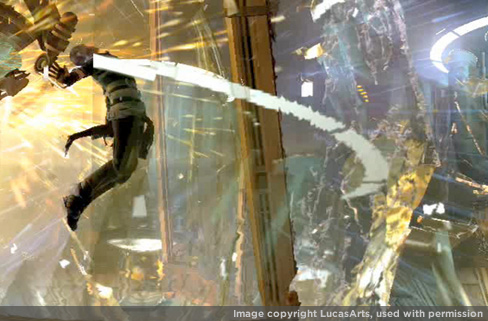
Founded: October 2003 in Geneva, Switzerland.
Mission: To make advanced simulation technology easy to use for the creation of visual assets. |
 |
|||||||
Executive Team:
|
2004: In Febuary, Pixelux Entertainment S.A. is founded in Geneva, Switzerland with the intent of developing technology that would automate art asset generation for video games through advanced simulation. To that end, the Company creates a unique real-time material physics simulation technology called "Digital Molecular Matter" or DMM.
2005: Pixelux partners with LucasArts to examine the potential of its new Digital Molecular Matter Technology for the simulation-based gameplay approach LucasArts plans to take for its next generation of games. The Pixelux-produced Stormtrooper Gun room demo code-named "Demo 2F" is a huge success within LucasArts and paves the way for DMM technology to be used inside of LucasArts' games.
2006: Pixelux signs an exclusive agreement with LucasArts to bring DMM into the gaming world by integrating it into LucasArts' two premier internally-developed titles: "Star Wars: The Force Unleashed" and "Indiana Jones". Work begins on an initial demonstration of DMM inside of LucasArts' custom game engine for E3.
2007: Due to the exclusive relationship with LucasArts, Pixelux is entirely focussed on refining and integrating DMM into "Star Wars: The Force Unleashed"
2008: The Force Unleashed is completed and released on September 16th. The demo of the game is made available on Xbox Live and Playstation Network for the Xbox360 and PS3. This demo becomes the fastest ever to reach the one million download mark, which occured in just eight days. The Force Unleashed sold 1.5 million copies globally across six platforms in the first five days of sale, becoming the fastest-selling Star Wars game of all time. LucasArts' exclusivity period on DMM technology ends. The first version of the DMM Plug-In allowing the use of DMM technology inside of Maya is released.
2009: DMM2 is announced with a GPU-accelerated version to be made available through a partnership with AMD. DMM is used in its first major motion picture production through WETA Digital's use of the DMM Plug-In in the hit motion picture "Avatar". LucasArts announces Force Unleashed 2
2010: A free format version of DMM2 is announced to be made available through a partnership with AMD. The Moving Picture Company licenses DMM for use in its Visual Effects Pipeline. The 3D Studio Max version of the DMM Plug-In is released. DMM is used in a major cinematic feature for the first time by WETA in James Cameron's "Avatar"
2011: "Sucker Punch", the first movie made with MPC's powerful new DMM-based KALI Destruction pipeline is released. MPC also uses KALI on "Source Code", "Harry Potter 7 part 2", as well as "X-Men: First Class" and "Sherlock Holmes: A Game of Shadows". Fuel VFX uses DMM on the showcase scene in "Mission Impossible Ghost Protocol"" where Tom Cruise smashes through a window on the outside of the Burj Dubai. Autodesk also begins including a limited version of DMM with Maya 2012
2012: MPC uses Kali on "Wrath of the Titans". Prime Focus uses DMM for the Queen's Cottage destruction scene in "Mirror Mirror". The ArtFX School includes DMM in its VFX curriculum on simulation. DMM Technology is in use by every major VFX house with the API version gaining interest for those wishing a greater degree of integration and realism.
Pixelux Entertainment, S.A. is a privately held corporation.




